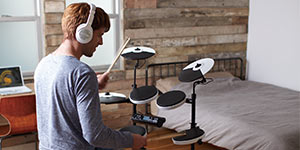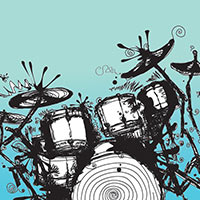Contributed by Roland UK Team
There’s nothing as exciting as buying new gear. This is especially true when you’re first starting to play an instrument. But for aspiring drummers, it can feel like there’s a lot to learn before you even pick up a set of sticks. With so much choice, you can – and should – get a kit that’s just right for you. What’s more, starting off with the right gear will help you achieve your goals more quickly. To make life easier, we’ve made this three-minute guide to buying a drum kit. It’ll fill you in on the basics and help you choose a set-up that works for you.
 Remember floor space and size
A full-sized drum kit can take up a lot of space, and when you’re setting up be prepared for things to spread out a bit. You’ll be surprised how far a kick/bass drum can travel in one practice session. You also might want to mention to your partner or family that you’re buying a drum kit. It’s best to stand close to the front door for this part, preferably wearing a crash helmet.
If you’re short on space, electronic kits can help. They have a smaller footprint than acoustic kits so they can easily squeeze into the corner of your room or your home studio. What’s more, they’re easy to assemble and dismantle so you can put them away and get your room back when you’re not rehearsing. They’re also easier to take out and about for band practice or gigs.
Remember floor space and size
A full-sized drum kit can take up a lot of space, and when you’re setting up be prepared for things to spread out a bit. You’ll be surprised how far a kick/bass drum can travel in one practice session. You also might want to mention to your partner or family that you’re buying a drum kit. It’s best to stand close to the front door for this part, preferably wearing a crash helmet.
If you’re short on space, electronic kits can help. They have a smaller footprint than acoustic kits so they can easily squeeze into the corner of your room or your home studio. What’s more, they’re easy to assemble and dismantle so you can put them away and get your room back when you’re not rehearsing. They’re also easier to take out and about for band practice or gigs.
 Buying your first drum kit
Buying your first drum kit
There’s nothing as exciting as buying new gear. This is especially true when you’re first starting to play an instrument. But for aspiring drummers, it can feel like there’s a lot to learn before you even pick up a set of sticks. With so much choice, you can – and should – get a kit that’s just right for you. What’s more, starting off with the right gear will help you achieve your goals more quickly. To make life easier, we’ve made this three-minute guide to buying a drum kit. It’ll fill you in on the basics and help you choose a set-up that works for you.
The basic five-piece drum kit
Drum kits can vary. Anything from the most simplistic two-piece ‘kick and snare’ setup (cymbals and hi-hats are not traditionally counted as ‘pieces’) to the most expansive eight- or nine-piece setups. Mostly these extra pieces are tom-toms (also known as ‘toms’). The kick drum and snare drum are a staple of every drum kit. Most drummers, however, will start out with a five-piece drum kit. This gives you plenty to practise and play with and it won’t confuse you with too many bells and whistles either. Here’s what’s involved:Drums
- Kick drum (also called bass drum)
- Snare drum
- Two rack toms
- Floor tom
Cymbals
- One hi-hat
- One ride cymbal
- One or more crash cymbals
 Remember floor space and size
A full-sized drum kit can take up a lot of space, and when you’re setting up be prepared for things to spread out a bit. You’ll be surprised how far a kick/bass drum can travel in one practice session. You also might want to mention to your partner or family that you’re buying a drum kit. It’s best to stand close to the front door for this part, preferably wearing a crash helmet.
If you’re short on space, electronic kits can help. They have a smaller footprint than acoustic kits so they can easily squeeze into the corner of your room or your home studio. What’s more, they’re easy to assemble and dismantle so you can put them away and get your room back when you’re not rehearsing. They’re also easier to take out and about for band practice or gigs.
Remember floor space and size
A full-sized drum kit can take up a lot of space, and when you’re setting up be prepared for things to spread out a bit. You’ll be surprised how far a kick/bass drum can travel in one practice session. You also might want to mention to your partner or family that you’re buying a drum kit. It’s best to stand close to the front door for this part, preferably wearing a crash helmet.
If you’re short on space, electronic kits can help. They have a smaller footprint than acoustic kits so they can easily squeeze into the corner of your room or your home studio. What’s more, they’re easy to assemble and dismantle so you can put them away and get your room back when you’re not rehearsing. They’re also easier to take out and about for band practice or gigs.
Discovering ‘your’ sound
Getting the right sound is the most exciting part of buying and setting up your new drum kit. The physical size of your drums (shell diameter and shell depth) will affect the sound. The material that they’re made from will also make a difference. Interestingly, different types of drums are better suited to different types of music. For example, acoustic drums are made of different woods:- Maple – Slightly boosted lows with smooth mid and high frequencies. Known for resonant or ‘open’ tones which are also bright yet warm
- Birch – Boosted high frequencies, and a strong low-end punch. Known for great attack and darker tones
- Mahogany – Extremely rich low-end frequencies, with beautifully smooth mids: ideal for styles requiring ultimate ‘bottom’ and punch, with plenty of attack
- Play hundreds of drum sounds, covering maple kits, birch kits, metal kits and even more. The modules on electronic kits come loaded with a variety of drum kits and sounds so you can change musical genres at the touch of button
- Use an in-built metronome (or ‘click’) to help with your timing
- Play along with songs or plug in your own MP3 player
- Adapt your kit whenever you want: an electronic kit is flexible and can grow with you as you develop, so you can customise your kit without shelling out on new gear

